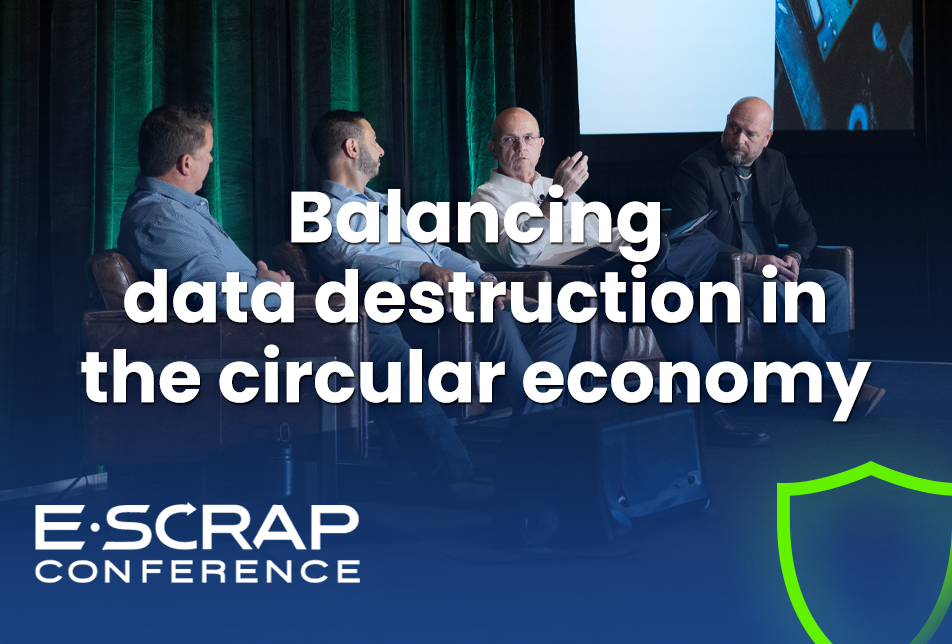
Benjamin Franklin was quite confident when he stated, “Nothing is certain but death and taxes.” But through years of experience, Guardian can confidently add another certainty to Ben’s: every job has a surprise.
Sometimes it’s the same headaches that every business deals with: Mother Nature, mechanical issues, or illness. In all instances, Guardian Data Destruction’s process is prescribed: immediately notify our VAR or ITAD client of the issue and provide alternative solutions or timings. Once approved and documented, the project managers at HQ verify and walk through the adjustment with the onsite team.
And then they move on—business as usual.
But we also encounter some situational humdingers. The following examples have one common denominator; they were quickly resolved with the same process we use for a flat tire or unexpected squall. Once the ITAD/VAR and their customer agree on the updated project plan, we get to work.
The root cause of a job scope surprise!

The fundamental cause of the onsite snags? There isn’t one.
A high percentage of Guardian’s projects flow through multiple layers with many stakeholders and fluctuating scopes. Information changed at one level doesn’t trickle down and responses don’t float up to the designated point of contact. Or there are physical unknowns or gradual scope changes that just aren’t noticed or flagged by offsite stakeholders.
Because we know that project communication can be like a game of telephone, the Guardian team aims to arrive prepared. Before going onsite, our teams review the jobs, know the site contacts, and have a “Plan B” and (possibly) a “Plan C”. As the team progresses through the day, they update their project managers regularly with status messages to keep our teams and the client in sync.
Top 10 every day, common surprises-upon-arrival of a data center decommissioning or data destruction project

Since most of our projects are onsite, the Guardian team prides itself a “can do” mindset—so that the job doesn’t come to a screeching halt. Our Operations Departments and Project Managers work tirelessly to learn as much as possible about the site and the scope of work before the job is scheduled, and yet surprises happen regularly.
When that surprises do happen, our primary focus is on how to convert a surprising challenge to “surprise, the job is done” without any compromise in security or chain of custody.
Common onsite revelations include:
- There’s no loading dock to wheel equipment off or load pallets of shred, hard drives, or IT assets.
- There is a loading dock but it’s an irregular size made for smaller trucks (common in older cities).
- The point of contact who is unaware that a scheduled job is…scheduled.
- The provided names of the project team weren’t sent to building security.
- The assigned site point of contact isn’t anywhere to be found. The backup point of contact’s number is incorrect.
- The assigned site point of contact is available but wasn’t told about the project or doesn’t know where the IT assets are.
- The confirmed onsite address is not the right address.
- The point of contact is in another country or time zone.
- The service elevator to move processed IT assets to a truck at the loading dock is broken or unavailable.
- The quantities on the paperwork are nowhere near the quantities waiting for the team aka some last-minute scope creep: “Well, you’re here, so…“.
In each situation, the structure of the Guardian process prevails: our onsite Team Lead immediately contacts their Project Manager (PM) with a description of the problem, and they put together their heads to devise solutions. The PM immediately confers with our ITAD/VAR who gets a final signoff from their customer on the new plan with minimal delays.
How to handle extraordinarily different project scopes
No matter how many planning meetings, confirmations, in-person walk-throughs and pre-project documents are in place, stuff happens. For us, we see situations like the Mini Case Studies below as an opportunity to prove why our customers rely on us.
| Service | Planned project scope | The Guardian “can-do” pivot | |
|---|---|---|---|
| 1 | IT Asset Logistics | Pick up and transport 35 server racks | Pick up and transport 192 server racks |
| 2 | Scan, verify and data erasure | Scan, verify and wipe 600 computers in 5 days | Scan, verify and wipe 2,500 computers in 2 weeks |
| 3 | Data destruction | Shred 100+ hard drives in 1 day | Shred 4,500 hard drives ASAP |
| 4 | Data destruction | Shred 10,000 hard drives in 5 days | Shred 45,000 hard drives in two weeks (including overnights) |
| 5 | Data center decommissioning | Decom 5 data center cages composed of 125 cabinets, 70 without wheels | Ungang and dismantled ladder racking locking in 80% of unwheeled cabinets |
| 6 | Data center decommissioning | Audit, white glove pack and remove 3 racks in 1 day | Audit, white glove pack and remove a full data center room in 1 week |
| 7 | Tape shredding | Shred 20,000 tapes onsite | The shred engine blew out almost immediately. Immediately drove another shred truck to the site and finished the job on time |
| 8 | Data center decommissioning | Prep (remove PDUs and wiring) and remove 1000 racks, cable mining from two 30k sq ft data centers | Prep (remove PDUs and wiring) and remove racks, cable mining, remove all CAT5/6 wiring above and below flooring, trace and remove 2000 power whips from two 30k sq ft data centers and multiple IT storage rooms to fill (24) 53ft trucks Fun fact: the final walkthrough took 2 days because the site was so big! |
| 9 | Audit, process and pack data center assets | Client-supplied servers, switches, firewalls, blade servers (hard drives pulled by internal staff) | 18TB of undocumented but installed data storage discovered, validated and shredded (SSDs, HDDs, PCIEs, M.2s, SATADOMs and soldered-on drives) |
RELATED: Read the case study here >
Calling an onsite audible (a team-based methodology)

Like many service providers, Guardian has built a process based on experience to handle scope changes that happen overnight. Because each situation is a mashup of different services, ITADs/VARs and end users, we rely on:
- The trusted relationship between Guardian and our ITAD/VAR channel partner.
- Direct, instantaneous and regular consistent communication from project beginning to the end—within the team and with the channel partner.
- Heads together immediately to develop a solution that meets the ITAD/VAR and end user’s needs with the least time delay.
- Zero tolerance for team idle time: keep the team working while the scope change is going through the (rapid) approval process.
- No sacrifice to data security, chain of custody or project efficiency
- A focused mindset from the outset:
- Not thinking that we have a problem, only how to solve it
- No stopping the work at hand while waiting for a change order
In the end, it’s about getting the job done in a way that pleases and is understandable to our channel partners and their customers that rely on secure, compliant and absolute data destruction and data center services.
If you’re a VAR, ITAD, MSP or reseller that is looking for a partner with the flexibility to meet your customers’ needs, talk to us >
Read next
- Read our other case studies >
- Learn more: Data destruction and data center decommissioning budgeting >
Sign up for email updates to receive the latest in data security options from Guardian Data Destruction >



